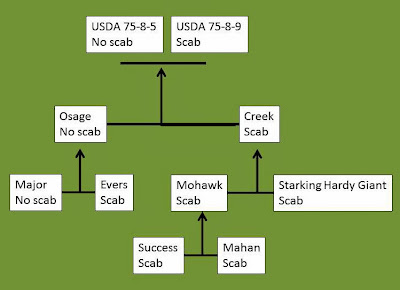 |
| USDA 75-8-5 |
 |
| USDA 75-8-9 |
Above is a flow chart of the ancestry of USDA 75-8-5 and USDA 75-8-9. The parents of these clones were the same: Scab resistant, Osage and scab susceptible, Creek. Going back another generation I found that the scab resistance of Osage originated from its Major parent. Looking at the ancestry of Creek, I found scab susceptibility in all cultivars that make up the Creek side of the family tree.
I don't think that scab resistance is a single gene inheritable trait because we see such a wide range of reactions to the scab fungus. However, a quick look at the family tree would lead me to expect that only a portion of Osage x Creek crosses would demonstrate some level of resistance to scab.
Even though 75-8-5 looked scab free in our trials in 2013, this USDA clone has demonstrated only mediocre scab resistance under conditions of high humidity in southern Georgia; a location of much higher scab pressure than SE Kansas (my location).
